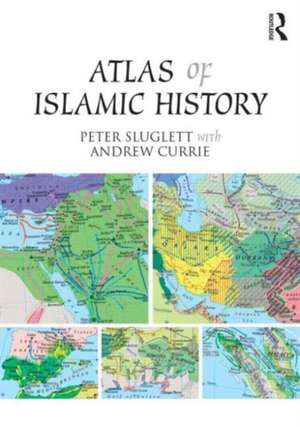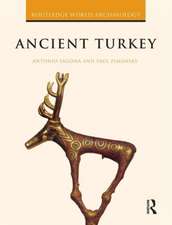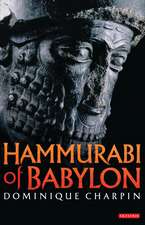Atlas of Islamic History
Autor Peter Sluglett, Andrew Currieen Limba Engleză Paperback – 25 noi 2014
Each map is accompanied by a text that contextualises, explains, and expands upon the map, and are fully cross-referenced. All of the maps are in full colour: 18 of them are double-page spreads, and 25 are single page layouts. This is an atlas of Islamic, not simply Arab or Middle Eastern history; hence it covers the entire Muslim world, including Spain, North, West and East Africa, the Indian sub-continent, Central Asia and South-East Asia. The maps are not static, in that they show transitions within the historical period to which they refer: for instance, the stages of the three contemporaneous Umayyad, Fatimid and ‘Abbasid caliphates on Map 10, or the progress of the Mongol invasions and the formation of the various separate Mongol khanates between 1200 and 1300 on Map 21. Using the most up to date cartographic and innovative design techniques, the maps break new ground in illuminating the history of Islam.
Brought right up to date with the addition of a Postscript detailing The Islamic World since c.1900, a Chronology from 500 BCE to 2014, and additional endpaper maps illustrating The Spread of Islam through the Ages and The Islamic World in the 21st Century, the Atlas of Islamic History is an essential reference work and an invaluable textbook for undergraduates studying Islamic history, as well as those with an interest in Asian History, Middle East History and World History more broadly.
Preț: 334.31 lei
Nou
Puncte Express: 501
Preț estimativ în valută:
63.97€ • 66.96$ • 53.24£
63.97€ • 66.96$ • 53.24£
Carte disponibilă
Livrare economică 10-24 martie
Livrare express 22-28 februarie pentru 33.69 lei
Preluare comenzi: 021 569.72.76
Specificații
ISBN-13: 9781138821309
ISBN-10: 1138821306
Pagini: 112
Dimensiuni: 229 x 300 x 13 mm
Greutate: 0.48 kg
Ediția:1
Editura: Taylor & Francis
Colecția Routledge
Locul publicării:Oxford, United Kingdom
ISBN-10: 1138821306
Pagini: 112
Dimensiuni: 229 x 300 x 13 mm
Greutate: 0.48 kg
Ediția:1
Editura: Taylor & Francis
Colecția Routledge
Locul publicării:Oxford, United Kingdom
Public țintă
UndergraduateCuprins
Global Map: The Spread of Islam Through the Ages 1 The Arabian Peninsula c.570 2 The Near East and the Mediterranean at the Advent of Islam c600 3 The expansion of Islam under the Prophet and the Rightly Guided Caliphs c622-661 4 The Umayyad Caliphate of Damascus 661-750 5 Islam and Christendom under Harun al-Rashid (786-809) and Charlemagne (768-814) 6 The Eastern Abbasid Caliphate at the Height of its Power 750-c820 7 The Emergence of Local Dynasties in the Eastern Abbasid Caliphate c820-c908 8 The Development of Muslim Rule in North Africa and Spain c800-c950 9 The Ghaznavids and the early Muslim Conquest of India c977-1099 10 The Decline of the Abbasid Caliphate and the Rise of the Fatamids c900-c1000 11 The Fatimid Caliphate and the Buyid State 945-1062 12 The Consolidation of Seljuq Power from 1040 to the Death of Malik Shah in 1092 13 The End of the Umayyad Caliphate and the Rule of the Muluk al-Tawa’if c1000-1086 14 Northwest Africa and Spain under the Almoravids c1050-1130 15 The Diffusion of Islam in West Africa c1000-c1500 16 New Muslim Dynasties in Iran, Central Asia and India c1092-c1206 17 Fatimids, Seljuks and Zangids 1092-c1170 18 Salah al-Din and the Rise of the Ayyubids c1170-1250 19 Trade Between the Western Islamic World and Europe c1100-c1300 20 Islam and the Trade of Africa and Asia c800-c1300 21 The Islamic World and the Mongol Invasions c1200-c1300 22 The Bahri Mamluks and the Ilkhanids c1250-1382 23 The Burji Mamluks and the Ottomans 1382-1517 24 Mongols and Turkmens in Iran and Central Asia c1300-c1500 25 Ottoman Expansion in Anatolia, the Balkans and Black Sea Lands c1300-c1520 26 North Africa and Spain under the Almohads c1130-c1250 27 Muslim Rule in North Africa and Spain at the end of the Reconquista c1250-c1550 28 India under the Delhi Sultanate 1206-c1400 29 India under the Sayyids, Lodis and early Mughals c1400-1605 30 The Spread of Islam in Southeast Asia c1275-c1600 31 The Rise of the Safavids and Expansion of the Ottoman Empire c1500-c1700 32 Islamic Russia, Central Asia and Iran c1450-c1750 33 The Development of Muslim States in North and West Africa c1500-c1650 34 The Mughal Empire from the Death of Akbar to the Death of Awrangzib 1605-1707 35 The Decline of the Mughal Empire 1707-c1820 36 Islamic Revival and Reform in India under British Rule c.1820-c.1910 37 Islam and Imperialism in Iran, Central Asia, Afghanistan and China c1750-c1920 38 The Ottoman Empire and the Sa'udi- Wahhabi State c1700-c1830 39 The Ottoman Empire and the Sau'di State c1830-c1914 40 Islamic Reform Movements in North and West Africa c1650-c1900 41 The Spread and Development of Islam in Eastern Africa c1500-c1900 42 The Development of Muslim States in Southeast Asia c1600-c1900 43 Religious Reform and Resistance to Colonisation in the Islamic World c1750-c1914 44 Global Map: The Islamic World in the 21st Century
Notă biografică
Peter Sluglett is Director of the Middle East Institute at the National University of Singapore. A historian of the Arab provinces of the Ottoman Empire in the late nineteenth and early twentieth centuries, and of the modern states of Iraq, Lebanon and Syria, he has taught Middle Eastern history at the University of Durham, England, and at the University of Utah, Salt Lake City. In 2012–13 he was President of the Middle East Studies Association of North America.
Andrew Currie is director of his own independent cartographic consultancy, Creative Viewpoint. A geography graduate of the University of Edinburgh, with a distinction in cartography, he continued post-graduate studies and hands-on application in map-making sciences at the University of Glasgow in the 1960s. He has since worked on a wide range of cartographic productions with several leading publishers of maps and atlases in the U.K. and the Middle East. He considers the Atlas of Islamic History to be his most satisfying and most challenging cartographic design project, since it takes account of all four dimensions - including mapping change through time.
Andrew Currie is director of his own independent cartographic consultancy, Creative Viewpoint. A geography graduate of the University of Edinburgh, with a distinction in cartography, he continued post-graduate studies and hands-on application in map-making sciences at the University of Glasgow in the 1960s. He has since worked on a wide range of cartographic productions with several leading publishers of maps and atlases in the U.K. and the Middle East. He considers the Atlas of Islamic History to be his most satisfying and most challenging cartographic design project, since it takes account of all four dimensions - including mapping change through time.
Recenzii
"It should be the essential accompaniment for any course teaching Islamic history up to the twentieth century."
Francis Robinson is Professor of the History of South Asia, Royal Holloway University of London.
"Sluglett and Currie’s Atlas has an elegance and ease of presentation since it offers a very useful visual presentation of major political and cultural shifts. The prose that accompanies each map has a succinct summary of important events."
Purnima Dhavan is Associate Professor in the Department of History, University of Washington.
"The Maps I have seen are outstanding quality that far surpasses any affordable atlas hitherto published…"
Sean Anthony is Assistant Professor in the Department of History, University of Oregon.
"It is a rare pleasure to review a book on a subject so complex and to find the product so pleasingly erudite and well presented. […] this atlas well illustrates the principle themes and trajectories of the Muslim past from the immediate pre-Islamic era to 1920. Peter Sluglett’s meticulous text is both thorough and insightful. He has examined contemporary scholarship in this field and elucidated it for the benefit of bibliophiles, who will also undoubtedly gain from Andrew Currie’s excellent cartographic skills. […] Above all, this atlas presents readers with crucial insights into the geographical challenges and ambiguities of the world of Islam over the past 14 centuries. Lavishly illustrated, rich in narrative and visual detail, Atlas of Islamic History will become an indispensable reference book for undergraduates studying Asia, the Middle East, Islam and Muslim history."
Abdullah Drury (June 2015): Atlas of Islamic History, Islam and Christian–Muslim Relations
Francis Robinson is Professor of the History of South Asia, Royal Holloway University of London.
"Sluglett and Currie’s Atlas has an elegance and ease of presentation since it offers a very useful visual presentation of major political and cultural shifts. The prose that accompanies each map has a succinct summary of important events."
Purnima Dhavan is Associate Professor in the Department of History, University of Washington.
"The Maps I have seen are outstanding quality that far surpasses any affordable atlas hitherto published…"
Sean Anthony is Assistant Professor in the Department of History, University of Oregon.
"It is a rare pleasure to review a book on a subject so complex and to find the product so pleasingly erudite and well presented. […] this atlas well illustrates the principle themes and trajectories of the Muslim past from the immediate pre-Islamic era to 1920. Peter Sluglett’s meticulous text is both thorough and insightful. He has examined contemporary scholarship in this field and elucidated it for the benefit of bibliophiles, who will also undoubtedly gain from Andrew Currie’s excellent cartographic skills. […] Above all, this atlas presents readers with crucial insights into the geographical challenges and ambiguities of the world of Islam over the past 14 centuries. Lavishly illustrated, rich in narrative and visual detail, Atlas of Islamic History will become an indispensable reference book for undergraduates studying Asia, the Middle East, Islam and Muslim history."
Abdullah Drury (June 2015): Atlas of Islamic History, Islam and Christian–Muslim Relations
Descriere
This Atlas provides the main outlines of Islamic history from the immediately pre-Islamic period until and endpoint of c. 1914, that is, before most parts of the Muslim world became sovereign nation states. It is primarily concerned with political and dynastic change across the globe over 15 centuries.

















